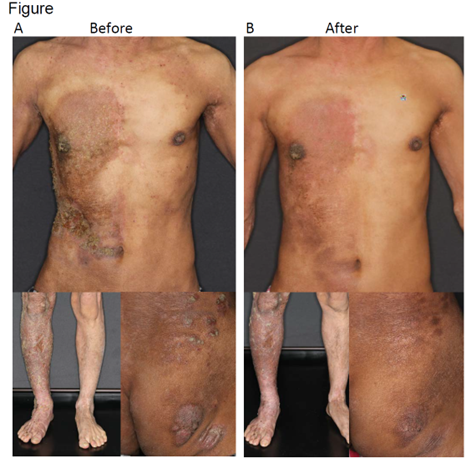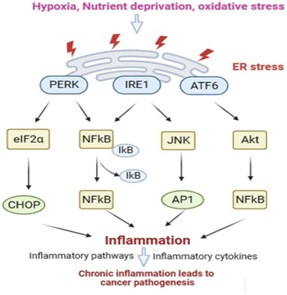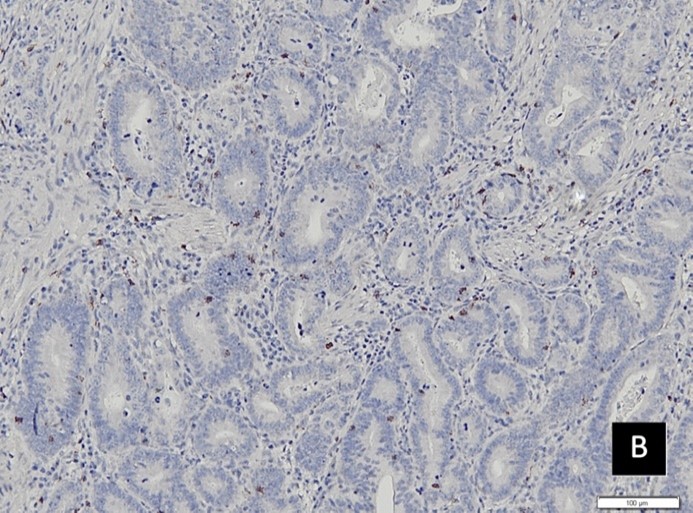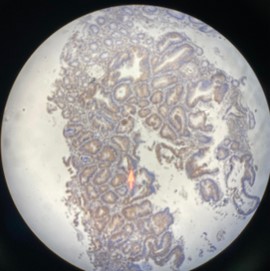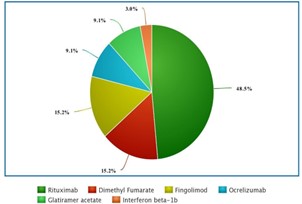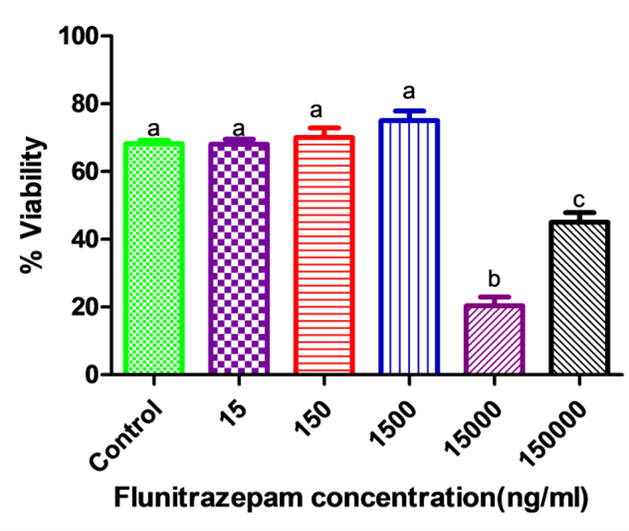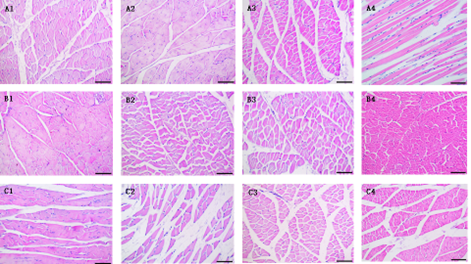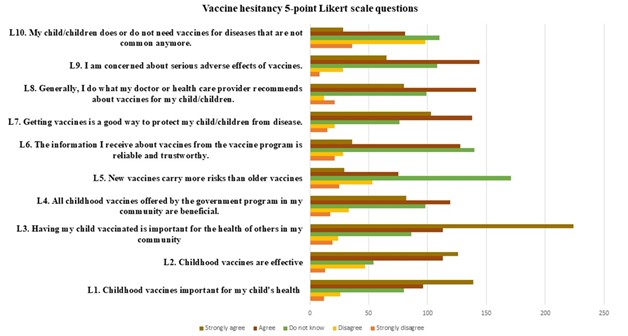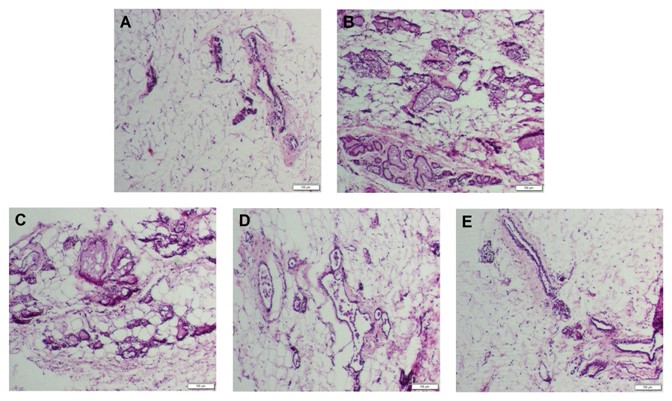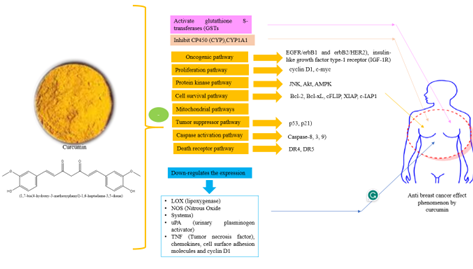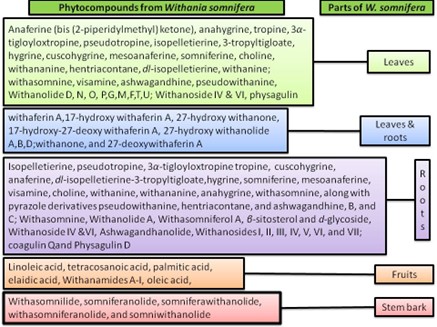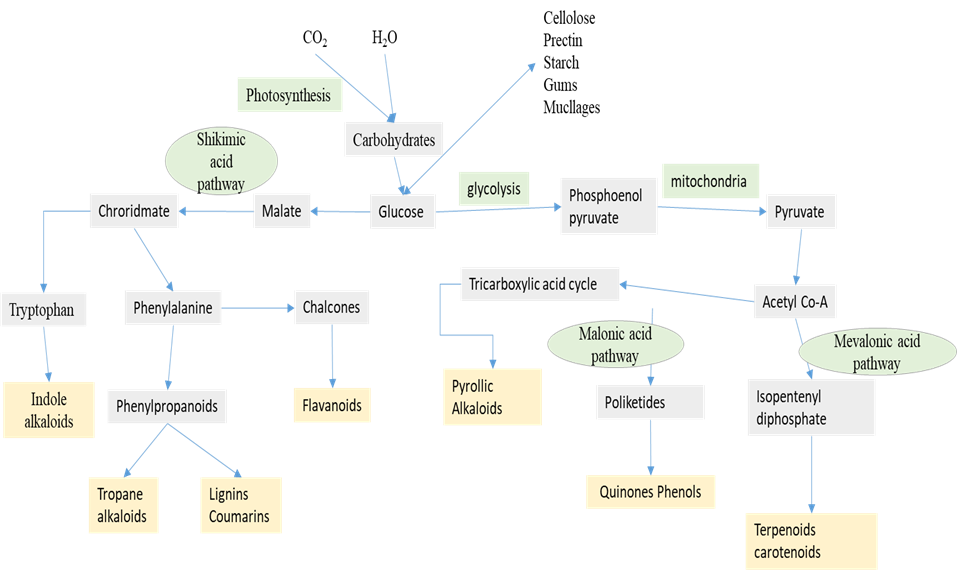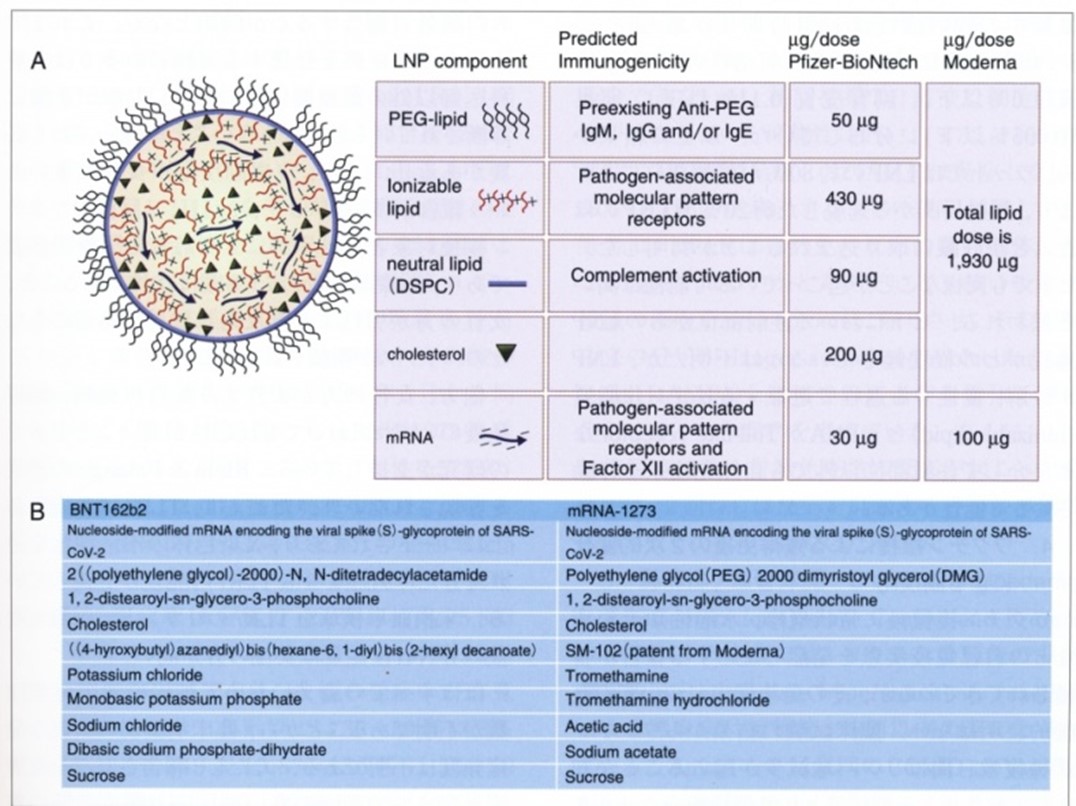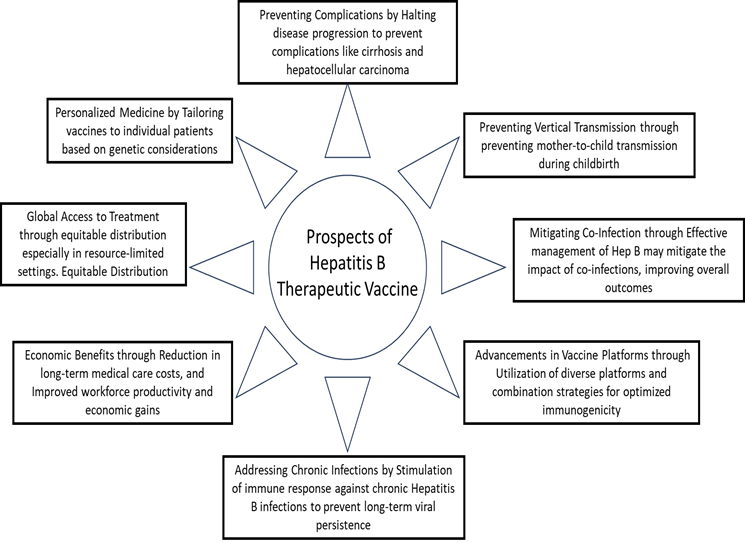Table of Contents
Epidermal Nevus Syndrome (ENS) is a congenital disorder characterized by skin lesions called epidermal nevi. This condition typically appears at birth or in infancy. However, a case of adult‐onset epidermal nevi was reported in a 36‐year‐old male with a history of atopic dermatitis (AD) and skin abnormalities on the right side of his body. He had been using topical steroids for AD but eventually started dupilumab treatment at age 41. The treatment led to significant improvements in his skin condition, including a reduction in erythema and scaling. Laboratory tests also showed improvement in serum Immunoglobulin E (IgE) levels and other markers. We report with a literature review.
Inflammation is a complex process which is associated with the initiation and progression of cancer. Prolonged Endoplasmic Reticulum (ER) stress triggers inflammation which is a key factor associated with cancer pathogenesis. ER stress also contributes to immune suppression in inflammatory and tumor microenvironment. It stimulates the production of pro-inflammatory cytokines by regulating the activation of various transcription factors and inflammatory signalling pathways. Targeting ER stress is an exciting possibility that can be used as a therapeutic strategy for cancer treatment. This mini review focuses on the emerging link between ER stress-induced inflammatory responses in cancer development.
Background: Thyroid carcinoma represents a significant global health burden, rising worldwide incidence. Papillary thyroid carcinoma (PTC) accounts for most cases, but aggressive variants with capsular invasion and nodal metastases require more intensive treatment. Reported rates of these capsular invasion and cervical lymph node metastasis vary widely. This study aimed to elucidate associations between clinical/tumor characteristics, capsular invasion, and nodal metastasis in Vietnamese PTC patients. Methods: This retrospective cohort study examined 1626 patients with cytologically/histologically confirmed thyroid carcinoma at a referral center in Vietnam during 2018–2020. Data collected included demographics, imaging, cytology, tumor features, capsular invasion, and nodal metastasis. Associations were analyzed using chi-squared tests and binary logistic regression. Results: Most patients were young (≤ 45) females with small papillary carcinomas. High rates of capsular invasion (58.7%) and nodal metastasis (28.5%) were observed. Capsular invasion was associated with higher TIRADS categories, Bethesda cytological categories, larger tumors, and papillary histology. Nodal metastasis was linked to younger age, male sex, higher TIRADS categories, larger tumors, papillary histology, and capsular invasion. Binary logistic regression identified TIRADS categories, Bethesda cytological categories, larger tumor size, younger age, male sex, and capsular invasion as independent predictors. Conclusion: Unexpectedly high rates of capsular invasion and cervical lymph node metastasis were found. TIRADS, Bethesda system, tumor size, age, sex, and capsular invasion were significant preoperative risk factors for aggressive PTC behaviors.
Background: The immunotherapy approach to colorectal cancer is becoming one of the key approaches to colorectal cancer treatment. One of the components of immune responses is tumor‐infiltrating lymphocyte CD8+ cells (TILs CD8+). While chemotherapy is one of the main treatments for colorectal cancer, we need to consider immunotherapy for advanced colorectal cancer. Thus, this study is aimed at finding the association between TIL CD8+ expression and chemotherapy response. Methods: This is a prospective cohort study with colorectal cancer patients in the Digestive Surgery division of a tertiary general hospital in West Java, Indonesia. An immunohistochemistry examination was used to evaluate the expression of TIL CD8+. The response evaluation criteria in solid tumors (RECIST) were used for the evaluation of chemotherapy response. Results: There were 53 research subjects included. There were 20 (37.7%) subjects with high expression of TILs CD8+; there were 30 (56.6%) subjects in stage III, followed by stage IV (17.32%) and stage II (6.11%). There were 18 subjects (34%) who showed progressive disease, 17 subjects (32.1%) showed partial response, and 16 subjects (30.2%) with high expression of TILs CD8+ showed partial chemotherapy response. The TILs CD8+ expression showed no significant relationship with age, sex, subtype, grade, or tumor location, but showed a significant relationship with stage and chemotherapy response (P < 0.05). Conclusion: High TILs CD8+ expression show a relationship with better chemotherapy response and a better prognosis based on disease stage in colorectal cancer patients.
Background: LC3 serves as a marker for assessing autophagy activity in cancer cells, which is a potential focus for therapeutic interventions. It holds the potential to serve as a predictive indicator of resistance to chemotherapy in colorectal cancer. Thus, this study is aimed at finding the association between LC3 expression, metastasis, and chemotherapy response in colorectal patients. Methods: This study was an observational study evaluating the stage and chemotherapy response of a colorectal cancer patient in a tertiary hospital in West Java, Indonesia. The research participants included in this study were 83 subjects. The examination of LC3 was performed with immunohistochemistry. The response evaluation criteria in solid tumors (RECIST) were used for the evaluation of the chemotherapy response. Results: A positive LC3 expression was shown in 58 (69.9%) patients. In positive LC3 expression, 20 subjects (27.4%) showed progressive response, 16 subjects (21.9%) showed stable response, 12 subjects (16.4%) showed partial response, and 1 subject (1.4%) showed complete response. Meanwhile, in negative LC3 expression, 12 subjects (16.4%) showed progressive response, 8 subjects (11%) showed stable response, 3 subjects (4.1%) showed partial response, and 1 subject (1.4%) showed complete response. The LC3 expression showed no significant relationship with age, sex, subtype, grade, tumor location, stage, or chemotherapy response (p > 0.05). Conclusion: The expression of LC3 showed no significant relationship with metastasis or chemotherapy response.
Objectives: Natalizumab is an injectable DMT (disease-modifying therapy) which used for RRMS (relapsing-remitting multiple sclerosis) since 2006. The drug has been available in Iran since 2014. Introduction: This study was aimed to evaluate the real-world effectiveness of Natalizumab in a referral center in Tehran, Iran. This study is the first real world analysis of efficacy and safety of Natalizumab in our country. Methods: In this retrospective study, patients with RRMS were investigated in a high-volume center in Tehran from 2019 to 2021. MS (Multiple Sclerosis) patients under treatment with Natalizumab who have received at least 3 infusions of the drug and had completed follow-up data, have been evaluated for safety and efficacy of Natalizumab. Results: 100 patients were included in the final analysis. The mean follow-up time was 20 months (6–33 months). The median EDSS (Expanded Disability Status Scale) score of patients reached to 2 from 2.5 after the treatment course (P < 0.0001). The annualized relapse rate (ARR) decreased from 0.81 (95% CI: 0.73–0.87) to 0.023 (95% CI 0.009–0.061). The median JCV (John Cunningham virus) index remained unchanged before treatment 0.85 (IQR: 0.21–2.41) compare to after the treatment 0.85 (IQR: 0.21–2.31). The number of patients with active brain and cervical MRI (Magnetic Resonance Imaging) lesions decreased significantly (P = 0.001). NEDA-3 (No evidence of disease activity) was improved from 9% to 87% after the treatment with Natalizumab. No serious adverse events except than one progressive multifocal encephalopathy (PML) case have been found. The main reasons of switching from Natalizumab to the other DMDs (Disease Modifying Drugs) were positive JC index, starting phase, noncompliance, pregnancy, MRI activity and seroconversion after starting the drug. Conclusion: Natalizumab is a safe and effective choice in RRMS patients for reducing relapse rate, disability score, active MRI lesion, and improving the NEDA (No evidence of disease activity).
The abuse of flunitrazepam, tramadol and levonorgestrel among adolescents is a major problem, with adverse effects on the immune system. Neutrophils serve as the host primary defense and employ the role of an essential enzyme, myeloperoxidase. This study investigated the in vitro effect of flunitrazepam, tramadol and levonorgestrel on the activity of the neutrophil. Neutrophils were isolated from blood samples of volunteers and seeded in culture plates, and then treated with flunitrazepam, tramadol and levonorgestrel. Trypan blue exclusion assay was used to assess the cytotoxic effect of flunitrazepam, (15, 150, 1500, 15,000, 150,000 ng/mL), tramadol (300, 3000, 30,000 µg/ml) and levonorgestrel (18.5, 185 and 1850 ng/mL) on the neutrophils, and the effect flunitrazepam (150,000 ng/mL), tramadol (30,000 µg/ml) and levonorgestrel (1850 ng/mL) on myeloperoxidase activity was assessed. The viability of neutrophils treated with flunitrazepam, (15,000, 150,000 ng/mL), tramadol (300, 3000, 30,000 µg/ml) and levonorgestrel (18.5, 185 and 1850 ng/mL) decreased significantly (p < 0.05) compared with control. Myeloperoxidase activity in neutrophils treated with flunitrazepam (150,000 ng/mL), tramadol (30,000 µg/ml) and levonorgestrel (1850 ng/mL) decreased significantly (p < 0.05) compared with background and positive control. This study revealed that flunitrazepam, tramadol and levonorgestrel altered the activity of myeloperoxidase and phagocytic activities of the neutrophil.
Objective: To evaluate the effect of HTK (Histidine-Tryptophan-Ketoglutarate solution) infusion on the protection and replantation of amputated limb. Methods: In experiment 1, the amputated limbs of male New Zealand white rabbits were preserved by different preservation methods, including low-temperature HTK solution perfusion group, low-temperature normal saline perfusion group, low-temperature preservation group and non-perfusion group at normal temperature. The homogenates of muscle tissue at different time points were collected for biochemical detection. H&E (hematoxylin and eosin) staining was performed on muscle tissue. Bax, Bcl-2 protein immunohistochemical staining and Tunel method were used to detect apoptosis in muscle, nerve, and vascular tissues. The ultrastructure of cells was observed by transmission electron microscope. In experiment 2, the amputated limbs of rabbits were treated with HTK perfusion and cryopreservation without perfusion, respectively. The survival of rabbits and their limbs were observed, and detected by H&E, TUNEL (Terminal deoxynucleotidyl transferase dUTP Nick End Labeling) and scanning electron microscopy. Statistical analysis was performed using SPSS 22 (SPSS Inc., Chicago, IL, USA). χ2 test, student’s t-test, and ANOVA (Analysis of Variance) were used to compare the categorical and continuous variables. Results: Experiment 1: With the extension of disconnection time, there were statistical differences between the biochemical indexes of the HTK liquid perfusion group and those of the non-low temperature non-perfusion group, while some indexes of the other groups were different. Immunohistochemical staining of tissues (muscle, nerve, and blood vessel) in each group showed that the number of cells stained by anti-apoptotic protein BCL-2 in each group significantly increased with the extension of time, while the number of cells stained by pro-apoptotic protein BAX2 in each group significantly decreased. Tunel test showed that compared with other treatment groups, the apoptosis rate of the HTK liquid group was significantly decreased. Experiment 2: The survival rate of the experimental group was 60%, and that of the control group was only 30%. H&E staining, the TUNEL method and scanning electron microscopy suggested that HTK infusion could reduce ischemia-reperfusion injury in muscle tissue. Conclusion: 1. Perfusion preservation of severed limbs at 4 ℃ can effectively reduce tissue damage caused by ischemia and hypoxia, and the effect is stronger than direct preservation. 2. HTK solution and normal saline were used for one-time perfusion of the severed limbs of rabbits, and the preservation effect of HTK solution was the best. 3. HTK solution was used for one-time perfusion of severed hind limbs of rabbits, which was refrigerated at 4 ℃ and then replanted (ischemia time was 3–5 h). Compared with the replanted limbs after cold storage alone, the survival rate was higher, and the postoperative ischemia and hypoxia injury of surviving limbs were less.
Objectives: This study aimed to assess the hesitancy towards vaccination and to identify the factors and predictor variables within the study population. Methodology: This was a cross-sectional study conducted via a web-based platform where a validated questionnaire was circulated among the public to understand their hesitancy towards vaccination. WHO SAGE Working Group Questionnaire was used to collect the data. The predictors for hesitancy were determined by using bivariate logistic regression analysis and the prevalence of vaccine hesitancy was identified. Results: A total of 353 subjects enrolled in the study during the 6 months of the study. Among them, 133 (37.67%) subjects showed vaccine hesitancy. On performing the bi-variate analysis, it was found that among the subsets studies those who were more hesitant to receive vaccines were females (OR: 1.476); individuals who are widowed/separated/divorced (OR: 3.109), age 40–49 yrs (OR: 3.710); from a rural (OR: 1.277) and not graduated (OR: 1.077). These subsets were predictors identified for vaccine hesitancy. Among the vaccines, maximum hesitancy was observed for the chicken pox vaccine [47 (13.31%)], followed by TCV [25 (7.08%)] and Rota [24 (6.79%), whereas the minimum hesitancy was observed for BCG [2 (0.56%)], OPV [4 (1.13%)] and IPV [8 (2.26%)]. Reasons provided for the hesitancy observed were mainly (i) Did not think it was needed [163 (46.17%)], (ii) Did not think the vaccine was safe [41 (11.61%)] and (iii) Did not know where to get vaccinated [24 (6.79%)]. Conclusion: The study observed less vaccine hesitancy among vaccines included in the EPI program. A major contributing factor for VH among the study population was their wrong perception about vaccines as that is not needed and not safe. Hence, there is a real need for education to the population to improve vaccine confidence among the general population.
The objective of this research was to determine the change in hepcidin levels and other biochemical markers, including total iron binding capacity (TIBC), serum iron, testosterone, and specific vitamins in the blood of individuals with β-Thalassemia. Here, 140 participants were involved in the study, of whom 110 were affected by β-thalassemia and 30 were healthy. The samples were obtained from Baqubah Teaching Hospital, the blood bank and blood donation center. The study was carried out from May 2022 to August 2022, and the patients were housed in Diyala Provence, Baquba City and its suburbs. The participants in this investigation were split into three groups: A: 55 male patients with β-thalassemia; B: 55 female patients with β-thalassemia; and C: 30 healthy individuals that were set as a control group. The findings of the study showed that the levels of HbA1 in males and females were 93.44 ± 0.71 and 93.53 ± 0.91, respectively, while the levels of HbA2 in males and females were 4.99 ± 0.59 and 5.29 ± 0.72, respectively. In contrast, the control group had HbA1 levels of 97.33 ± 0.40 in males and 97.66 ± 0.46 in females, but HbA2 levels were 2.32 ± 0.33 in males and 2.24 ± 0.24 in females. The study revealed remarkable differences (P < 0.05) between these variables. Hematological measures, such as hemoglobin concentration and percentages of mean corpuscular volume (MCV), packed cell volume (PCV), and mean corpuscular hemoglobin (MCH) were substantially reduced (P < 0.05) in β-thalassemia patients when compared to the controls. Serum iron and TIBC were significantly increased (P < 0.05), while Hepcidin levels were markedly decreased (P < 0.05) in the serum of β-thalassemia patients compared to controls. Therefore, as a conclusion the reduction of hepcidin levels and increase in iron levels are correlated with β-thalassemia and can be used as a biomarkers in monitoring β-thalassemia disease.
Background: The aim of the present study was to evaluate whether the HMG (Hyperplasia of the Mammary Gland) effect of RuXian-I in estrogen- and progestogen- induced HMG rats is mediated through the activation of MAPK (Mitogen activated protein kinase) and NF-κB signaling pathways. Materials and methods: Fifty virgin female Wistar rats were randomly divided into in control and HMG, RuXian-I (0.75 g·kg−1, 1.5 g·kg−1, 3 g·kg−1, respectively) groups, 10 in each. Injections of estrogen and progestogen were given to establish rat models of HMG and RuXian-I at the same time. Changes in nipple heights were measured; pathologic changes of HMG in rats were also observed under a light microscope; the phosphorylation levels of MAPK and NF κB and the expression levels of TNF-α and IL-1β were measured. Results: Compared with the control group, the nipple diameters and height were increased significantly, the numbers of MG lobules were increased, there were changes in breast histopathology, the levels of TNF-α and IL-1β increased significantly, and MAPK and NF-κB were activated in HMG rats. Compared with the HMG model group, the increased nipple height was decreased, the numbers of MG lobules were reduced, the degree of HMG in rats was alleviated obviously, and the phosphorylation level of MAPK and NF-κB and cytokines TNF- α and IL-1β levels in serum were decreased by RuXian-I treatment. Conclusion: Those results suggest RuXian-I has protective and therapeutic effects on HMG rats induced by estrogen and progestogen and is likely to activate MAPK and NF-κB signaling pathways.
A frequent benign breast tumor, fibroadenoma mammae (FAM), has extra stromal and epithelial components in the breast tissue. Despite not being fatal, FAM increases breast cancer risk, highlighting the necessity to recognize it. Estrogen and progesterone levels during menstruation, pregnancy, and lactation may alter FAM development. Therefore, this study examines FAM risk variables in adult women at South Tangerang Regional General Hospital, Indonesia. Adult women in General Hospital of South Tangerang City, Indonesia were studied using a case-control design with 85 cases and 85 controls. South Tangerang General Hospital recruited volunteers between December 2023 and January 2024 using purposeful sampling. FAM patients with a history of therapy were cases, while Eye Clinic patients without FAM were controls. Viral diseases, major cardiovascular problems in the past three years, and unstable weight were excluded. Multivariate analyses employed multiple logistic regression, while univariate and bivariate analyses used percentages and chi-square test. Fibroadenoma mammae (FAM) prevalence in adult women at South Tangerang General Hospital is highly correlated with age, age of menarche, family history, hormonal contraceptive use, and nutritional status. Abnormal nutrition was the largest risk factor for FAM in hospitalized adult women (aOR = 8.678, p < 0.000). The study stresses the link between nutritional state and FAM, with abnormal nutritional status increasing risk. This shows how diet and nutrition affect FAM sensitivity. To reduce FAM prevalence, demographic, genetic, hormonal, and lifestyle factors must be understood and addressed due to their complex interaction. Dietary strategies that promote healthy eating may reduce FAM risk.
One of the primary concerns for women in good health is breast cancer. The most typical hazardous growth is this one. It spreads easily, and the clinical conditions are terrible. Bosom illness is the second‐most common type of malignant tumor that regularly causes women to pass away in the U.S. bosom malignant growth is the most well‐known disease among women worldwide, with 2.1 million cases reported in 2018 and more than 620,000 fatalities per year. Natural components are viewed as promising alternatives for the development of novel anti‐tumor drugs. Curcumin, also termed diferuloylmethane, is a yellow pigment made by the turmeric plant, Curcuma longa Linn. It is the curcuminoid and polyphenol present in the plant’s root that is most abundant. The antioxidant and anti‐inflammatory qualities of curcumin have been demonstrated, and it is frequently utilized in traditional medicine and cuisine. Due to its sophisticated pharmacological capabilities of chemoprevention and anticancer effects, curcumin, the main component of turmeric, has been linked to the treatment of breast cancer. The morbidity or mortality of the disease have not been significantly decreased by current breast cancer treatment options such as surgery, radiation, adjuvant chemotherapy, or hormone therapy. The expansion, estrogen receptor (trauma center), and human epidermal development factor receptor 2 (HER2) pathways are all involved in the activity of curcumin in illness. In breast cancer cells, curcumin is also known to regulate microRNA, cell stage-related characteristics, and apoptosis. This study reviews recent research on the atomic targets and anticancer effects of curcumin in breast cancer.
Withania somnifera is a famous medicinal plant. It is popularly known as Aswagandha. This plant has been in use in Ayurveda and Unani medicine for ages. The medicinal plant has immense medicinal properties. The plant is rich in potent medicinal phytocompounds. These phytocompounds are known to have potent antioxidant, antiviral, antibacterial and immunomodulatory efficacies. Our immune system is the key player in n fighting back any kind of pathogeni attack on us. Withania somnifera extract and certain isolated phytocompounds from the plant are known to boost our immune system. Studies show that the mechanisms of immunomodulatory actions of the bioactive phytocompounds from Withania somnifera are by affecting the various cellular signaling pathways. These primarily involve the signaling pathways associated with the receptors present on the vital immune cells like the dendritic cells, T-cells and B-cells. Thus, some of the compounds of Withania suppress or activate certain components of the innate and adaptive immune system. Unlike synthetic adjuvants, the natural plant derived phytocompounds and their derivatives, as those from the Withania sp. are free from such risk factors. A strong immune system is the best possession to fight back invasions by microbes like bacteria and viruses like the SARS-CoV-2. Detailed and compact knowledge of the compounds from Withania sp. and their mechanism of modulating and impacting our immune system may make the ways for development of new supportive therapies against almost all different types of diseases including COVID 19.
Studies conducted on the chemical composition of the genus Trichilia have isolated and identified 334 different compounds such as monoterpenes, diterpenes, sesquiterpenes, triterpenes, limonoids, steroids, coumarins, lignans, flavonoids, amino acid, phenolic acids, and lactones. This genus is used in traditional medicine for the manufacture of antibacterial, antioxidant, antiviral and antimalarial drugs. Indeed, our research with numerous Trichilia species has revealed that these plants exhibit antioxidant, antibacterial, anticholinesterase, neuroprotective, anti-inflammatory, and anti-anaphylactic properties against pathogens of major clinical value. The properties of analgesia, liver protection, and immunomodulation are also being studied. This study summarizes the main therapeutic uses of Genus Trichilia of species mentioned in the article and encourages future research into their usage in the treatment of various ailments as antimicrobial and anticancer.
The Mongolian nomadic nation has created bone healing, or fracture healing, which is suitable for the extreme weather and territory, unique living conditions, and physical characteristics while struggling to fight diseases during a long historical period. Gradually, this treatment method has gradually developed into a more comprehensive theoretical system throughout history and has unique names due to the thinking scope of the Mongols, their cognition development, and thus their use of it in their everyday lives and continuing to enrich their knowledge. Mongols have rich experience healing bone fractures and injuries from ancient times. They are usually used to perform bone setting and massage therapy. On the other hand, they have experience using herbal and mineral medicines to heal bone fractures and injuries. During their practice, the knowledge of herbal and mineral medicines used for bone fractures and injuries became expansive. After Buddhism reemerged in the 16th century, Mongolian doctors and knowledgeable people wrote many medical books in Tibetan. One of the major representatives was Jambaldorj, who wrote Mongolian materia medica, called “The beautiful wondrous eye ornament,” based on “Four medical tantras.” In treating bone fracture and injury in traditional medicine, firstly, the four treatment methods mentioned in “Four medical tantras” are the main principles and methods, which are wind, bile and phlegm theory, dietary recommendations, advice on behavior, prescribing medicine, and accessory therapy. We concluded that the names of herbal and mineral medicines used to practice bone setting are the same, even though they are mentioned in various sources.
Interferon Gamma (IFN-γ) plays a vital role in normal immune surveillance and possesses immunomodulatory, antimicrobial, and anticancer properties. It stands as the exclusive type II IFN, and its production is regulated by cytokines released by Antigen-Presenting Cells (APCs), particularly interleukin (IL)-12 and IL-18. These cytokines act as a connecting link between infection and IFN-γ production in the innate immune response. The functional IFN-γ receptor (IFNGR) consists of two ligand-binding IFNGR1 chains and two signal-transducing IFNGR2 chains, along with associated signaling machinery. Both IFNGR1 and IFNGR2 chains belong to the class II cytokine receptor family, characterized by ligand binding in the small angle of a V formed by the two Ig-like folds in the extracellular domain. Autoantibodies targeting interferon-gamma (IFN-γ) can lead to immunodeficiency and are linked to various opportunistic infections. The immunopathogenesis is associated with the neutralizing activity of these autoantibodies on the IFN-γ signaling pathway, resulting in the blocking of certain immune responses activated by IFN-γ. This review provides a concise overview of IFN-γ Autoantibody detection, the immunopathogenesis of related diseases, and potential treatment options.
Cutaneous adverse reactions (CARs) after COVD-19 messenger ribonucleic acid (mRNA) vaccines have been reported worldwide, but the pathophysiology of CARs remains to be elucidated. To understand the pathophysiology, it is essential to know how the innate and adaptive immunity are activated after vaccination. At present, majority of CARs are presumed to be evoked by innate immunity response. Reviewing the previous articles, I propose the clinical classification of CARs; local injection site reaction, generalized eruption, localized eruption and others. Since COVID-19 mutates continuously to overcome the existing vaccines, our steady efforts are indispensable to clarify the pathophysiology of CARs and contribute to the development of novel vaccines with least adverse events and high efficacy.
Hepatitis B therapeutic vaccines hold great promise in the treatment of chronic Hepatitis B virus (HBV) infection. However, like any medical intervention, they also face certain prospects and challenges which forms the aim of this critical review. Therapeutic vaccines offer a targeted approach to manage chronic Hepatitis B infections, aiming to stimulate the immune system to recognise and eliminate infected cells. The potential to halt disease progression holds promise for preventing severe liver diseases associated with chronic Hepatitis B, such as cirrhosis and hepatocellular carcinoma. Therapeutic vaccines, if effective, could contribute to a more equitable distribution of treatment options globally, especially in resource-limited settings. Hepatitis B therapeutic vaccines may play a crucial role in preventing vertical transmission, reducing the global incidence of perinatal HBV infections and improving maternal-child health outcomes. Diverse vaccine platforms and combination strategies, including immunomodulation and checkpoint inhibitors, are advancing, optimising immunogenicity, and eliciting strong immune responses. Tailoring therapeutic vaccines to individual patients based on genetic considerations may enhance efficacy, recognizing the genetic diversity of Hepatitis B. Therapeutic vaccines need to align with global health goals related to infectious disease elimination, contributing to broader efforts to reduce the burden of Hepatitis B worldwide. While Hepatitis B therapeutic vaccines hold significant promise in transforming the management of chronic infections, addressing challenges related to access, viral variability, and long-term monitoring is crucial for their successful integration into global healthcare strategies.












 Open Access
Open Access
